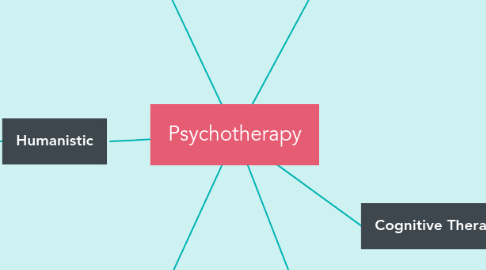
1. Group Therapy
1.1. Focuses on providing psychotherapy treatment in a format where there is typically one therapist and six to twelve participants with related problems in order to offer participants the opportunity to interact with others with similar issues in a safe, supportive environment.
1.1.1. Can be useful to help those who struggle interacting with others and sharing how they feel. Provides a supportive environment to people whose mental illness make them feel alone.
1.1.1.1. One advantage of this therapy is that people can improve not only from the interventions of the therapist, but also from observing others in the group and receiving feedback from group members.
1.1.1.2. One disadvantage of this therapy that if a group has too many people or just some very talkative people, some people may not get the time that they need to express their feelings.
1.1.2. Family therapy is a type of group therapy that is designed to address specific issues affecting the health and functioning of a family.
2. Humanistic
2.1. Carl Rodgers
2.1.1. Focuses is to help the client develop a stronger, healthier sense of self, as well as access and understand their feelings to help gain a sense of meaning in life.
2.1.1.1. Useful in helping people fulfill their individual needs. This is achieved through self-directed growth and change, with the person choosing which issues to explore, as they know best which problems are of greatest importance to them.
2.1.1.1.1. One advantage of this therapy is that its non-directional nature of person-centered counseling will allow clients to feel more comfortable when communicating with counselors.
2.1.1.1.2. One disadvantage of this therapy is that it requires the person receiving the therapy to be self-driven enough to come up with their own goals.
2.1.1.2. Client Centered Therapy is a type of humanistic therapy that is a non-directive form of talk therapy, meaning it allows the client to lead the conversation and does not attempt to steer the client in any way.
3. Interpersonal
3.1. Focuses on helping people deal with roles disputes, interpersonal shortcomings, life stage transitions, relational conflict, grief, and other attachment issues.
3.1.1. Useful in treating depression and other mental issues because if people are suffering from mental health issues their relationships often suffer. Improving these relationships can help the person with their symptoms.
3.1.1.1. One advantage of this therapy is that not only helps the person with their mental health issues, but it also puts people into the person's life as a support system.
3.1.1.2. One disadvantage of this therapy is that people in treatment must have a level of awareness and understanding of interpersonal relationships in order to work on them, and this is not always possible.
3.1.2. Expression of emotion is a type of interpersonal therapy that that focuses on helping the person express their emotions in a healthy way.
4. Behavior Therapy
4.1. B.F Skinner
4.1.1. Focus is on helping an individual understand how changing their behavior can lead to changes in how they are feeling by increasing the person’s engagement in positive reinforcing activities.
4.1.1.1. Useful in helping those who suffer form a mental illness that would result in maladaptive behavior. Could be beneficial for those with substance abuse problems and those with anger management issues.
4.1.1.1.1. One disadvantage of this therapy is that it can take a very long time to modify behavior, so if you need to see immediate changes in your life this might not be the therapy for you.
4.1.1.1.2. One advantage of this therapy is that not only does it help people get rid of thier bad habits, it replaces them with positive ones.
4.1.1.2. DBT is a type of behavioral therapy that is used to treat those with Boarderline Personality Disorder.
4.1.1.3. Desensitization is a type of behavioral therapy that aims to remove the fear response of a phobia, and substitute a relaxation response to the stimulus by gradually using counter conditioning.
5. Cognitive Therapy
5.1. Aaron Beck
5.1.1. Focus is on helping people identify and evaluate negative thinking in order to change their underlying beliefs about themselves, their world and other people.
5.1.1.1. Useful in treating those with depression who experience a constant stream of negative thoughts. This therapy can be used to retrain thought processes into something more positive.
5.1.1.1.1. One advantage of this therapy is that it can be tailored to any one person's needs. One person may need to work on one thing for a month, another may only need two days, but this method can be changed to meet the needs of everyone.
5.1.1.1.2. One disadvantage of this therapy is that it focus on fixing thought patterns instead of the actual mental issues that they stem from.
5.1.1.2. CBT is a type of cognitive therapy that works by changing people’s attitudes and their behavior by focusing on the thoughts, images, beliefs and attitudes that are held and how these processes relate to the way a person behaves, as a way of dealing with emotional problems.
6. Psychodynamic
6.1. Sigmund Freud
6.1.1. Focus on the client’s self-awareness and understanding of the influence of the past on present behavior.
6.1.1.1. Useful in changing an aspect of one’s identity or personality or to integrate key developmental learning missed while the person was stuck at an earlier stage of emotional development.
6.1.1.1.1. One advantage of this therapy is that because it is the oldest of the modern therapies, it is based in a highly developed and multifaceted theory of human development and interaction.
6.1.1.1.2. One disadvantage of this theory is that it can take years to see significant results.

